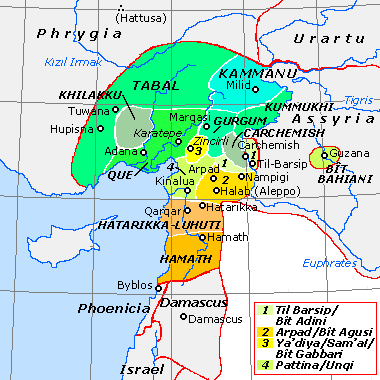|
Luash
Luhuti, Lukhuti or Lu'ash, was an Iron Age Syro-Hittite states, Syro-Hittite Aramean region during the early 1st millennium BC located in northern Syria, in an area that used to be called Nuhašše. Political Situation and Capital Luhuti was a region of uncertain political status, known primarily from Assyrian inscriptions, and the stele of Zakkur king of Hamath. Luhuti is never attested as a kingdom of its own or as having a single central authority, although it did constitute an independent interconnected region. The Assyrian inscriptions that describe Luhuti as a country with many cities and troops. Luhuti had many cities. Tell Sukas, Shuksi was the maritime center, But the most important center and capital was the city of Tell Afis, Hazrik (modern Tell Afis, Known as Hatarikka to the Assyrians), located 45 kilometer south of Aleppo. History Luhuti was first attested in 870 BC. The inscriptions of Ashurnasirpal II record his conquest of its neighbour Pattin, then his use of Pa ... [...More Info...] [...Related Items...] OR: [Wikipedia] [Google] [Baidu] |
Stele Of Zakkur
The Stele of Zakkur (or ''Zakir'') is a royal stele of King Zakkur of Hamath and Luhuti (or Lu'aš) in the province Nuhašše of Syria, who ruled around 785 BC. Description The inscription was on the lower part of the original stele. The upper part is now missing; it probably had the statue of king Zakkur sitting on a chair. Only some small parts of the upper part are still preserved such as the feet. Discovery The Stele was discovered in 1903 at Tell Afis (mentioned in the Stele as ''Hazrach''), 45 km southeast of Aleppo, in the territory of the ancient kingdom of Hamath. It was published in 1907. The long inscription is known as KAI 202; it reads, in part: :''I am Zakkur, king of Hamath and Luash . . . Bar-Hadad, son of Hazael, king of Aram, united against me seventeen kings . . .all these kings laid siege to Hazrach . . . Baalshamayn said to me, "Do not be afraid! . . .I will save you from all hese kings whohave besieged you"''Ivor Poobalan“The Period of Jeroboam ... [...More Info...] [...Related Items...] OR: [Wikipedia] [Google] [Baidu] |
Bit Agusi
Bit Agusi or Bit Agushi (also written Bet Agus) was an ancient Aramaean Syro-Hittite state, established by Gusi of Yakhan at the beginning of the 9th century BC. It had included the cities of Arpad, Nampigi (Nampigu) and later on Aleppo Arpad was the capital of the state-kingdom. Bit Agusi stretched from the A'zaz area in the north to Hamath in the south. Chronology According to Dan'el Kahn, there were seven stages of Bit Agusi history in Northern Syria in the ninth and eighth centuries BC. * Stage 1 (858–ca. 842 BC). Early on, Bit Agusi was apparently free of political alliances with neighbors. Arame, the second king of Bit Agusi, submitted to Assyria freely in 858 BCE, along with many other rulers of the region, including the southern Anatolia. * Stage 2 (841–823 BC). A period of Bit Agusi subjugation to Assyria. * Stage 3. Around 823 BC, or maybe a little later, Bit Agusi leads a local alliance opposing Assyrian hegemony, and achieves independence. * Stage 4. Also, soon ... [...More Info...] [...Related Items...] OR: [Wikipedia] [Google] [Baidu] |
Tell Afis
Tell Afis is an archaeological site in the Idlib region of northern Syria, and lies about fifty kilometres southeast of Aleppo. The site is thought to be that of ancient Hazrek (or Hazrach; Hatarikka for the Assyrians) capital of Luhuti. History Occupation of the site is stretching from the fourth millennium BCE to the Neo-Assyrian period. Late Bronze Around 1350 BC, the Hittite ruler Suppiluliuma I gain control over the northern parts of Syria. This region was then called Nuhasse. Levels VII to V have been firmly dated to the time of control by 13th century BC Hittite ruler Hattusili III by seals, pottery, and several tablets. Iron Age In the Iron Age, Tell Afis was in the Kingdom of Hamath. The Stele of Zakkur, dated c, 785 BC, which contains a dedication in Aramaic to the gods Iluwer and Baalshamin, was discovered here in 1903. Three additional Aramaic fragments were later found. Archaeology The tell is 28 hectares in area (570 meters by 500 meters) with an extensive low ... [...More Info...] [...Related Items...] OR: [Wikipedia] [Google] [Baidu] |

